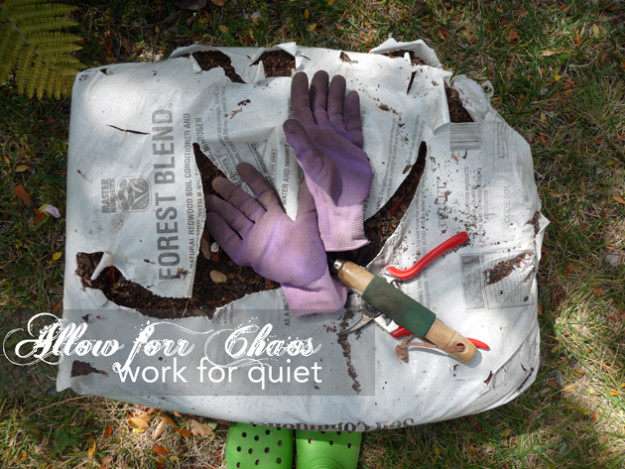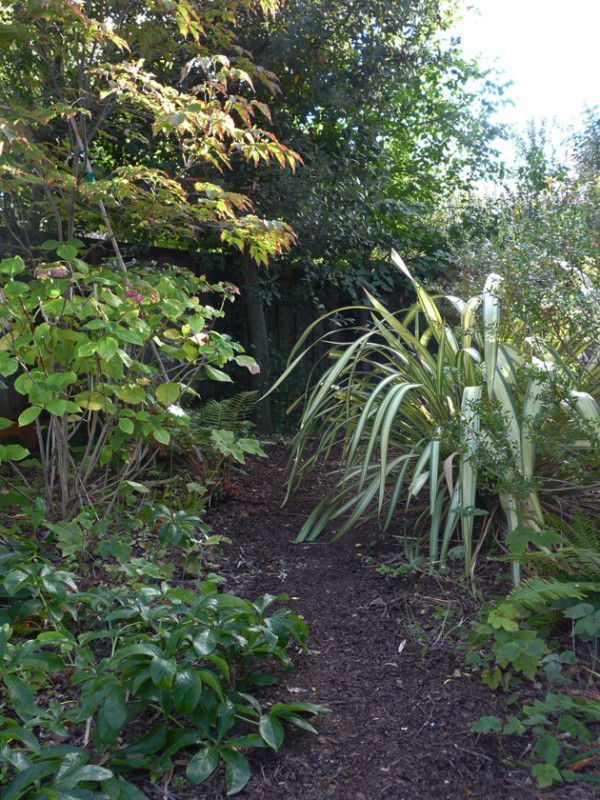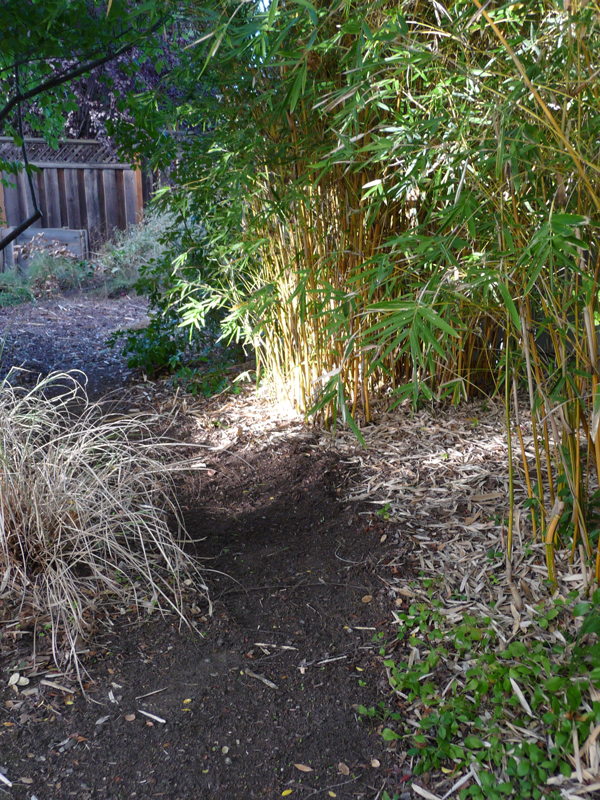
In fashion, I err on the side of repression. I wear less color and flash than my personality might support. High WASPs are like that and always have been, we worship appropriate, and set our dashboard to flash an early warning for impropriety.
In the garden, however, I err on the side of letting go. And where this takes me, often, is down a path to the joy and rhythm of mess.
How so? In modern landscaping, at least in California, landscapers often rely on what I think of as “wallpaper vegetation,” i.e. affix 6 dozen impatiens to your front yard and be done. The green stuff lives, if you can call it that, dies, gets replaced. Not a lot of meditation, nor wandering.
In these gardens, paths are usually concrete, buttressed by fir bark mulch extending around.
The paths in my back yard, on the other hand, threaten to merge right into the ground. Any carefully lain flagstones are obscured, often as not, by debris. Sometimes accidentally, when leaves fall from a Chinese elm and fronds lie down on ferns, sometimes on purpose, when I clean up and leave piles.
Cleaning is one of my favorite parts of gardening. Such a contrast when you finish, such an opportunity for a new perspective. In process,

and done. You can see how the light changed as I worked.

When I first announced that I’d be widening the blog scope beyond clothing to house and garden, you all recommended Tara Dillard. Thank you very much. She writes often about the importance of “flow,”in garden design. And she also says, “Your landscape cannot have too many entries.” I’m glad someone who knows their stuff insists that mess is creative, paths to nowhere actually “entries.”
Some of my “paths” in fact, are nothing more than unplanted space. You know to walk through only by the suggestion of green and ground, and they disappear in a few months, if neglected.

To really clear the way, I even have to pull out plants I love. Japanese anemones are gorgeous creatures, their little white flowers perch on the long stalks like singing birds. You can see one flowering above, others ready to bloom, in that lower right hand corner.
And then removed, bare ruined choirs covered in compost, below. The entry is back.

This is not big statement gardening. No showy flowers, no firepit, a distinct lack of putti. Just enough work done to manifest the owner.
My motto, which I only managed to articulate because I’m trying to explain to you why this isn’t just laziness, which it resembles? Allow chaos, work for quiet. In other words, I like to lose paths and then remake them,

even when they lead to untrammeled bamboo, unused side doors, or a regular old garden fence. As another reputable design source once said, “The eye has to travel.”

29 Responses
I like gardens that aren’t too manicured, a little wild. Does your yard have any grass, or any seating areas? Do you use if for anything? Curious.
@kathy, I have a front lawn. Small. In the back yard, there is also a small lawn, currently much the worse for wear due to drought and to protecting the elm tree from further sprinkler damage. I like to have a small grassy area, something to walk across, and I have never found a ground cover that I like as much to replace lawn. As for seating, we’re working on that. I have a slate patio – I can show it in a later post if that’s of interest, and right now it houses a nice teak bench, an ugly white round table, and a hideous small Weber grill:). I’m thinking over what to do with it – I don’t like too much seating/furniture outside, it messes with my fantasy that I live in the wilds.
I understand about living in the wild, but I agree with Bungalow Hostess that having a good area to sit and relax beckons one out to enjoy your garden.
When you said that a garden can’t have too many entries, I immediately started assessing the entries in our garden. And, I see this point! It’s nice to think you might be going somewhere, or entering an area.
@Susan, Exactly. It keeps the imagination moving on beyond the suburban limits:).
My kind of garden, executed in a very different climate — interesting to see that! And to see this expression of you.
Yes, every time I see your garden photos I have the same reaction:).
Your garden is lovely and peaceful, Lisa. I love shade. How large is your back yard? All the paths make it seem large.
@Marie, It’s not large, the lot is not quite 1/4 acre. The paths and the trees and the layering of plantings create an illusion of space that I love. The guy who designed it originally, is wonderful. He’s up in Oregon now, so I’ve been fidgeting with this for the past 20 years, first with some other local people, and now by myself with help on the heavy lifting. Anyone who lives too far away to work with Tara Dillard should give Jeff Sawastuk at Froghouse Gardens a call:).
I have tried to tame some areas of the garden and reclaim them from past mistakes…bamboo!
I think seating areas and garden “rooms” are important as they beckon one to sit and take in the beauty or chaos and are a great spot for a break from the labour of tending one’s garden.
I really like slate stones and the path you have chosen to use as it winds it’s way through your garden is lovely. I look forward to seeing more of your green thumb projects.
@Bungalow Hostess, Thanks oh gardener par extraordinaire! I like garden “sections” but in terms of a “room,” I only like actual chair seating right next to my house. That way I can pretend that my little yard stretches out into the wilderness. It’s idiosyncratic, but there you have it.
I like messy gardens so I think yours is lovely.
How do you keep the bamboo from taking over the whole yard? My parents had it planted in their side yard in Southern California and it wanted to swallow up the whole house.
@Wendy Bird, Good question. This stand has been in place for at least 15 years. I have a few volunteer patches, but not many. I remember Jeff telling me that it was a non-invasive species – I guess that was at least close to true?
That is the best opening line, ever.
@That’s Not My Age, Ha! I thank you ma’am!
the idea of flow links up with the basic principle of martial arts – let your opponent’s energy do the work. Gardening is so much like that! Sit and watch your yard, then work with it, not against it. Very satisfying, very non-biscuit cutter results, and comparatively low maintenance.
Drought is an interesting challenge to work with – heading into what promises to be another harsh summer in Australia. Picking the right plants for the aspect and effective wind barriers/softeners make all the difference.
@Erika, That is a great concept – gardening as martial arts. Thank you.
I love your garden and the slate walks. I think I basically prefer gardens that are a little wild and that offer the thrill of discovery.
@Mardel, <3
Lovely stuff – very restful and doesn’t look like too much hard work. I love Japanese Anenomes as well – so pretty and they look quite effortless as they keep coming back.
@Eleanorjane, It’s not much hard work at all – the leaves can fall where they may, only the paths to clear. I prune, not often, and that’s work I enjoy.
lisa your garden is my favorite kind of garden. i can appreciate the well manicured look but messy looks better in my opinion. i feel like i can relax in a messy garden!
yours is beeeautiful!
@the gardeners cottage, Oh, thank you so much! I breathe more deeply whenever I’m out there.
I adore your natural paths. The best gardens look a bit wild, and always have a place where you can steal a kiss.
In that case it’s a veritable makeout party in my backyard:). Thank you ma’am.
“Allow chaos, work for quiet” My motto for life from now on. Thanx, once again, Lisa.
<3
Gardeners are stewards of the land and we all have the capacity to maintain habitat for urban wildlife. Insects, reptiles, birds all benefit from the shelter and food sources of native plants, patches of untended garden and debris. We need them as much as they need us. No pollinator insects – no fruit. Sterile, perfectly (often chemically) maintained gardens do little for the soul and even less for the environment.
Reasonable garden mess is virtuous. And fun.
Wonderful. I am always looking for some extra virtue.